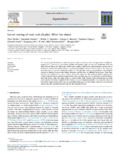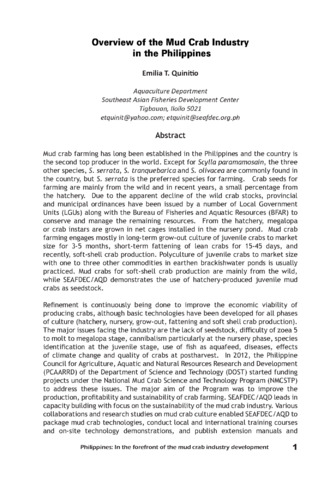| dc.contributor.author | Pates, Gaudioso S., Jr. | |
| dc.contributor.author | Quinitio, Emilia T. | |
| dc.contributor.author | Parado-Estepa, Fe D. | |
| dc.date.accessioned | 2017-08-16T10:00:37Z | |
| dc.date.available | 2017-08-16T10:00:37Z | |
| dc.date.issued | 2017 | |
| dc.identifier.citation | Pates Jr., G. S., Quinitio, E. T., Quinitio, G. F., & Parado-Estepa, F. D. (2017). Morphological deformities in mud crab Scylla serrata juveniles exposed to antibiotics during the larval stage. Aquaculture Research, 48(5), 2102-2112. | en |
| dc.identifier.issn | 1355-557X | |
| dc.identifier.uri | http://hdl.handle.net/10862/3156 | |
| dc.description.abstract | The effects of antibiotics on the external deformities, growth and survival of mud crab Scylla serrata larvae and juveniles were determined. Zoeae were exposed to oxytetracycline (OTC) (0, 3.0, 6.0, 9.0, 12 mg L-1) and furazolidone (FZD) (0, 0.5, 1.0, 1.5, 2.0 mg L-1) in the first and second experiments, respectively, until the late megalopa. The crab instars were grown in nursery tanks for 1 month. Larvae survived until megalopa only at 3.0 and 6.0 mg L-1 OTC or 0.5 and 1.0 mg L-1 FZD. These four concentrations were run simultaneously in another experiment. Morphological deformities in zoea 5 were bent dorsal, rostral and furcal spines. There was no significant difference (P > 0.05) on the deformities of zoea 5 in 3.0 and 6.0 mg L-1 OTC and 0.5 and 1.0 mg L-1 FZD. Significantly (P < 0.05) higher survival and faster growth were attained in 3.0 mg L-1 OTC and 0.5 mg L-1 FZD. Deformities observed in juveniles were fused frontal and lateral spines, asymmetrical and depressed tip of abdominal flap and gap between sternites. High percentage occurrence of deformities was observed in the 6.0 mg L-1 OTC and 1.0 mg L-1 FZD in the first and third experiments, respectively. There was no significant difference (P > 0.05) observed in the survival of juveniles in OTC and FZD treatments. However, growth was significantly (P < 0.05) faster in lower concentrations of the two antibiotics. The study shows the effects of OTC and FZD in the morphology of mud crab. Therefore, there is a need to eliminate the use of antibiotics and find alternatives. | en |
| dc.description.sponsorship | The study is part of the project on the Refinement of Feeding and Water Management Strategies in Larval Rearing of Mud Crab (Nr-02-C2010T; SEAFDEC/AQD) and the M.Sc. thesis of the first author. The comments and suggestions of Dr. Harold Monteclaro and Mr. Roman Sanares of the University of the Philippines Visayas, Miagao, are greatly appreciated. Likewise, the assistance of Mrs. Mercedes Pates is acknowledged. | en |
| dc.language.iso | en | en |
| dc.publisher | Wiley | en |
| dc.subject | Decapoda | en |
| dc.subject | Scylla serrata | en |
| dc.title | Morphological deformities in mud crab Scylla serrata juveniles exposed to antibiotics during the larval stage | en |
| dc.type | Article | en |
| dc.citation.volume | 48 | |
| dc.citation.issue | 5 | |
| dc.citation.spage | 2102 | |
| dc.citation.epage | 2112 | |
| dc.citation.journalTitle | Aquaculture Research | en |
| dc.subject.asfa | juveniles | en |
| dc.subject.asfa | growth | en |
| dc.subject.asfa | larvae | en |
| dc.subject.asfa | disease control | en |
| dc.subject.asfa | tanks | en |
| dc.subject.asfa | mud | en |
| dc.subject.asfa | survival | en |
| dc.subject.asfa | antibiotics | en |
| dc.subject.asfa | zoeae | en |
| dc.identifier.essn | 1365-2109 | |
| dc.identifier.doi | 10.1111/are.13046 | |
| dc.subject.scientificName | Scylla serrata | en |



